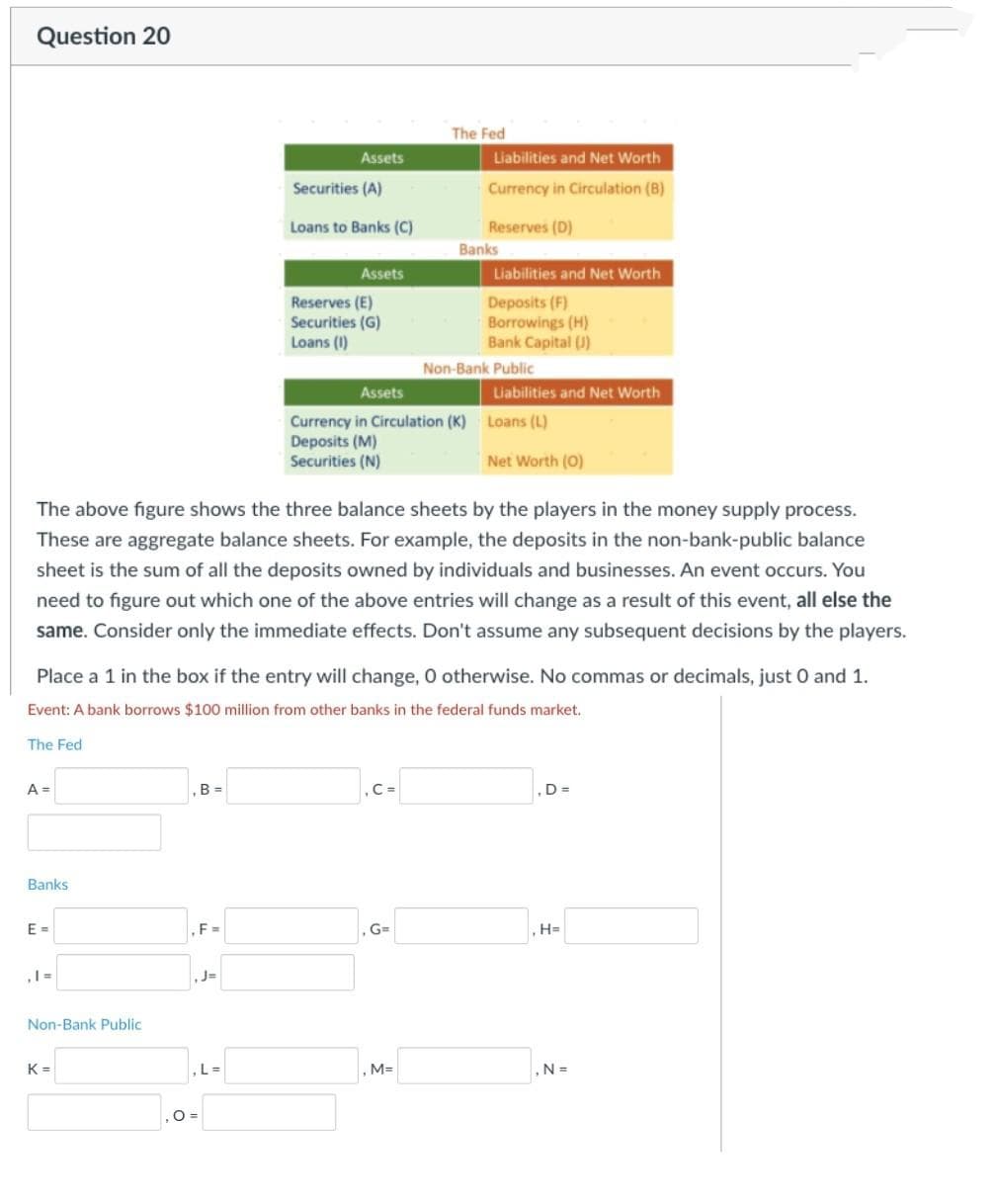A = Banks E= Non-Bank Public K= B = , F = Assets ,J= Securities (A) Loans to Banks (C) The above figure shows the three balance sheets by the players in the money supply process. These are aggregate balance sheets. For example, the deposits in the non-bank-public balance sheet is the sum of all the deposits owned by individuals and businesses. An event occurs. You need to figure out which one of the above entries will change as a result of this event, all else the same. Consider only the immediate effects. Don't assume any subsequent decisions by the players. , L = Assets Place a 1 in the box if the entry will change, 0 otherwise. No commas or decimals, just 0 and 1. Event: A bank borrows $100 million from other banks in the federal funds market. The Fed Reserves (E) Securities (G) Loans (1) Liabilities and Net Worth Currency in Circulation (B) Reserves (D) C= Banks Assets Currency in Circulation (K) Loans (L) Deposits (M) Securities (N) G= Liabilities and Net Worth Deposits (F) Borrowings (H) Bank Capital (J) Public Liabilities and Net Worth ,M= Non-Bank Net Worth (0) ,D= ,H= , N=
A = Banks E= Non-Bank Public K= B = , F = Assets ,J= Securities (A) Loans to Banks (C) The above figure shows the three balance sheets by the players in the money supply process. These are aggregate balance sheets. For example, the deposits in the non-bank-public balance sheet is the sum of all the deposits owned by individuals and businesses. An event occurs. You need to figure out which one of the above entries will change as a result of this event, all else the same. Consider only the immediate effects. Don't assume any subsequent decisions by the players. , L = Assets Place a 1 in the box if the entry will change, 0 otherwise. No commas or decimals, just 0 and 1. Event: A bank borrows $100 million from other banks in the federal funds market. The Fed Reserves (E) Securities (G) Loans (1) Liabilities and Net Worth Currency in Circulation (B) Reserves (D) C= Banks Assets Currency in Circulation (K) Loans (L) Deposits (M) Securities (N) G= Liabilities and Net Worth Deposits (F) Borrowings (H) Bank Capital (J) Public Liabilities and Net Worth ,M= Non-Bank Net Worth (0) ,D= ,H= , N=
Chapter14: Macroeconomic Policy: Tradeoffs, Expectations, Credibility, And Sources Of Business Cycles
Section: Chapter Questions
Problem 8E
Related questions
Question
4

Transcribed Image Text:Question 20
The Fed
A =
Banks.
E=
Non-Bank Public
K=
B =
,F=
Assets
, L =
O=
Securities (A)
Loans to Banks (C)
The above figure shows the three balance sheets by the players in the money supply process.
These are aggregate balance sheets. For example, the deposits in the non-bank-public balance
sheet is the sum of all the deposits owned by individuals and businesses. An event occurs. You
need to figure out which one of the above entries will change as a result of this event, all else the
same. Consider only the immediate effects. Don't assume any subsequent decisions by the players.
Assets
Place a 1 in the box if the entry will change, 0 otherwise. No commas or decimals, just 0 and 1.
Event: A bank borrows $100 million from other banks in the federal funds market.
Reserves (E)
Securities (G)
Loans (1)
The Fed
|, C =
Liabilities and Net Worth
Currency in Circulation (B)
Reserves (D)
G=
Banks
Assets
Currency in Circulation (K) Loans (L)
Deposits (M)
Securities (N)
, M=
Liabilities and Net Worth
Deposits (F)
Borrowings (H)
Bank Capital (1)
Public
Liabilities and Net Worth
Non-Bank
Net Worth (0)
,D=
,H=
,N=
Expert Solution
This question has been solved!
Explore an expertly crafted, step-by-step solution for a thorough understanding of key concepts.
Step by step
Solved in 2 steps

Knowledge Booster
Learn more about
Need a deep-dive on the concept behind this application? Look no further. Learn more about this topic, economics and related others by exploring similar questions and additional content below.Recommended textbooks for you


Principles of Economics 2e
Economics
ISBN:
9781947172364
Author:
Steven A. Greenlaw; David Shapiro
Publisher:
OpenStax


Principles of Economics 2e
Economics
ISBN:
9781947172364
Author:
Steven A. Greenlaw; David Shapiro
Publisher:
OpenStax